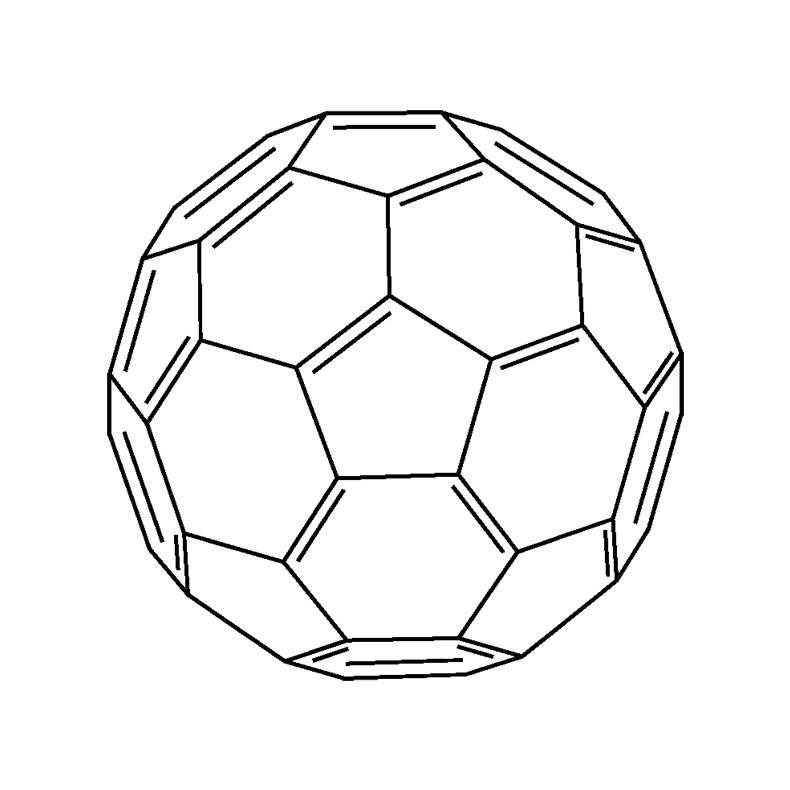 Fullerene C60
Fullerene C60
Fullerenes C60 and their applications in sensors
Fullerenes are a class of carbon molecules that have unique electronic, optical, and chemical properties. These properties make them attractive for use in various types of sensors.
High purity Fullerene-C60 (carbon 60, or C60, fullerenes) for use in thermal evaporation systems as either electron acceptors, n-type semiconductors, or interface layers.
We do offer regular grades which may contain traces of volatiles (solvents) as 99.50% – 99.90%. High purity solvent-free C60 is also offered as 99.50%+ to 99.99%+ grades, specially formulated for biological oriented R&D and processes demanding ultra-pure fullerenes.
Synthesized via a Solvent-Free Method. [1]
Green chemistry.
Environmentally friendly synthesis using renewable energy. [2]
[1] Solvents and volatiles are removed by subjecting the C60 to a controlled heat-cool process under dynamic inert medical nitrogen in order to suppress oxidation and preserve its pristine nature.[2] Hydroelectric powered plant in Quebec.
 Fullerene C60 Applications in sensors
Fullerene C60 Applications in sensors
- Gas and vapor sensors. Due to its high specific surface area and ability to adsorb and desorb molecules. Example: detection of toxic gases in the chemical industry, detection of gas leaks in the oil and gas industry, detection of exhaust gases in the automotive industry.
- HighThermometers. Due to its ability to change its electrical resistance in response to changes in temperature. Example: temperature monitoring in chemical manufacturing, temperature monitoring in food production, temperature monitoring in pharmaceutical manufacturing.
- Humidity sensors. Due to its ability to change its electrical conductivity in response to changes in humidity. Example: Moisture monitoring in food and pharmaceutical production.
- Pressure sensors. Due to its ability to change its electrical resistance in response to changes in pressure. Examples: pressure monitoring in hydraulic and pneumatic systems, pressure monitoring in the manufacture of chemical products, among others.
- Optical sensors. Due to its unique optical properties. Examples: light detection in the photovoltaic industry, light detection in the display industry, light absorption monitoring in chemical manufacturing, among others.
- The unique properties of fullerenes and their derivatives make them promising materials for use in various types of sensors, and ongoing research is aimed at further optimizing their properties and developing new sensing applications.
References
“Versatile fullerenes as sensor materials”
Ref: https://www.sciencedirect.com/science/article/abs/pii/S2468519421000343
“Functionalized Fullerenes and Their Applications in Electrochemistry, Solar Cells, and Nanoelectronics”
Ref: https://www.mdpi.com/1996-1944/16/3/1276
“Electrochemical Sensors and Their Applications: A Review“
Ref: https://www.mdpi.com/2227-9040/10/9/363
“Nano-carbons in biosensor applications: an overview of carbon nanotubes(CNTs) and fullerenes (C60)”
DOI: 10.1007/s42452-020-2404-1


Fullerene C60
SOL5060
Various Grades available to fit your formulations, device fabrication processes and methods.
Download PDF QuotationSOLARIS CHEM
AMERICA
-
Headquarters & Labs
3650 Bld. Cité-des-Jeunes,
Suite 101, Vaudreuil-Dorion,
Quebec, Canada
J7V 3Z6 -
(579) 217-0260
Toll free: (855) 489-3557 - Solaris Chem America
SOLARIS CHEM
EUROPE
-
Rnda. Circunvalación 188, M.11,
12003, Castellón, Spain - +(34)643637196
- Solaris Chem Europe
SOLARIS CHEM
MIDDLE EAST
-
15, 4th Floor, Bldg. No. 5.,
Wafa Complex, Street 103,
Area 6
Farwaniya, Kuwait - +965 66459915
- Solaris Chem Middleast
SOLARIS CHEM
SOUTHEAST ASIA
-
(Singapore, Malaysia, Thailand, Indonesia, Vietnam, Philippines, Myanmar)
No. 27 Woodlands Industrial Park E1,
#03-02, Singapore, 757718 - +65 9363 8706
- Solaris Chem Southeast
SOLARIS CHEM
TAIWAN
-
(Taiwan, China, Hong Kong)
2F., No. 67, Aly. 30, Ln. 136, Kangle St., Neihu Dist.,
Taipei City 114, Taiwan (R.O.C.) - +88 69 8900 9807
- Solaris Chem
SOLARIS CHEM Representative
JAPAN
-
(Japan)
TOSCO Co. LTD.
401 Daido Bldg., 3-5-5,
Uchikanda, Chiyoda-ku
Tokyo 101-0047, Japan - +813 5295 6316
- +81 5295 6311
- Website
- Solaris Chem Japan
